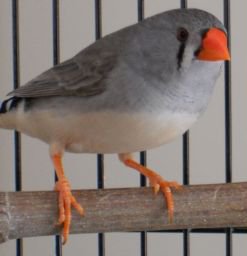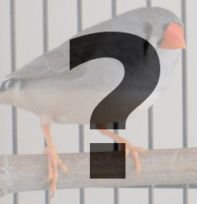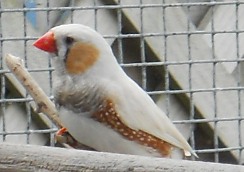Zebra Finches
Contributions, research and write up by Israel. Page is a work in progress.
Zebra finches are high energy finches from the Estrildidae family, found in the wild in Australia and can be kept quite happily as pets or for breeding and showing. Zebra finches are a society bird, so at a minimum should be kept in pairs for company (or more in aviaries). Zebra finches are prolific breeders, happy to mate and nest all year round if given the right environment, and with clutches of up to 5 eggs at a time their numbers can quite easily swell.

They are hardy birds, capable of surviving the NZ weather (even in Dunedin!), but don't easily adapt to human interruptions to their busy lives, preferring avian company. They can be quite happily kept with other finches and soft bills (Canaries etc) in aviaries, adding a little bit more energy and colour to the mix!
DID YOU KNOW:
Zebra Finches' technical name is Taeniopygia guttata. The Taeniopygia genus contains Australian finches, and the other member, the Double-barred Finch, is also kept by bird fanciers.
Sexing Zebra Finches
Fortunately Zebra finches are an easily sexed bird species (on the whole) as the males and females have distinctly different plumage (with one exception). As per the norm, the males are the showy ones, with orange cheeks, zebra-style stripes down their chest (often with a black bar as well), and brown flank feathers with white spotting. They are also the singers, as they try and court their partner. Females are much plainer, with a cream coloured belly compared to the males' white, and are otherwise grey in all the areas that the male has his showy spots.
This of course changes somewhat when you start looking at the different varieties of Zebra Finch, but the basics still hold true - the males have all the patterns whereas the females do not. The only exception to this rule is the 'White' mutation, where both the males and the females are pure white with no markings. From experience, though, the males generally have a deeper red beak colour than the females for this strain, but it is not an exact science.

Varieties & Colours
Zebra finches have a wide range of colours and varieties, many of which can link for interesting combinations and stranger names. Below you will find a gallery of the common varieties that can be found in Dunedin.













Behaviour
Zebra Finches are high energy birds, always moving about, beeping and meeping, flying gracefully from one perch to another, and scattering to the four winds (if they can) if someone startles them or gets too close. They reinforce their bond with their chosen mate through mutual preening, and will also quite happily laze on the perch beside them. The male is often the one who does the bulk of the nest building, and at nights zebra finches are quite grateful to be able to sleep in a nest.
DID YOU KNOW:
Scientific research at Japan's RIKEN institute has suggested that singing to females is an emotionally rewarding experience for male Zebra Finches! source: Wikipedia

Diet
Millet, rape, linseed, and canary seed are all quite happily eaten by Zebra Finches. They can be fed greens as well to help vary their diet, but they also have a tendency to put some of it (like chickweed) straight into their nests. Cuttlebone should also be considered a staple of the Zebra Finch diet.
Breeding
All things considered, Zebra Finches are rather easy to accommodate. Give them a source of nesting material and a nesting site, and away they go. But like all birds they do have their preferences and can be picky. Unlike society finches, who will all quite happily try and pile into the same nest, Zebra Finches can be territorial, and like to have their nest away from the others. Hence nesting sites should be spread around the aviary, so that the pairs can each find a spot they like and hopefully leave the others alone. Remember, even though they like sleeping in nesting boxes, if you give them such they will breed, and are capable of doing so all year round once they are in breeding condition.
DID YOU KNOW:
A well looked after Zebra Finch can live for 7 - 10 years or more!
The number of finch pairs you can have per aviary depends on space, but when you have more than one pair they will start to argue somewhat. The initial wisdom gleaned from the internet seemed to suggest that you needed at least 2 square feet per pair, and that the best odds for successful rearing was either one pair or three or more pairs in each aviary in order to distribute the harassment and hence lessen it. However, 2 pairs per aviary seems to be popular within our club, and it works, possibly because of the space, and the other birds present. Personal experience seems to show that 2 pairs did not work, but there were many other circumstances that also have an effect on success. If you want to keep the pairs you picked together while in an aviary it is best to give them some time together in a cage to let the bond form, and they should stay together while in the larger setting.

It has a moveable lid so that the chicks can
be observed/banded etc.
Finches prefer deep and enclosed nesting boxes — common versions have either round holes or square holes, and most finches are happy with this style. Of course there are always many options, and Zebra finches have been known to build nests in seed dishes (especially the ones with a partial roof), or other locations that take their fancy even if they are not to yours. Twine makes good nesting material, as does grass, natural fibres, and the like (even chickweed, which they would rather put into their nests than eat) and lining the bottom of your nesting boxes with a nest liner or pine needles is always a good idea. To help kick start the building of a nest, putting handfuls of the nesting material inside the nesting site is a good option. Both males and females will help build the nest, though often the male will do the bulk of the work, and can also start building a new nest over the top of the old one, sometimes even when the chicks are still in there! They will source material from wherever you have provided it, and also from other nesting sites as well.
When picking partners for breeding, how you pair them up depends on what goal you are wanting to achieve. If you're breeding for colours then you'll be matching them up by their colours, hopefully with some knowledge of their heritage, but if you are breeding for show then you'll be pairing your best cock with your best hen, irrespective of colour.
Useful Links
- Wikipedia Entry for Zebra Finches
- Zebrafinch.info - A very useful resource on Zebra Finches, including genetics info